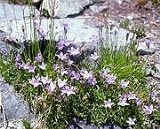
Campanula wilkinsiana
Encyclopedia
Campanula wilkinsiana is a rare species of bellflower
known by the common name Wilkins' bellflower. It is endemic to California
, where it is known fewer than twenty scattered occurrences in the Klamath Mountains
and Cascade Range
, and possibly the northern peaks of the High Sierra. It grows in temperate coniferous forest and mountain meadows. This is a perennial herb growing from a slender rhizome
and producing an erect or leaning stem up to about 30 centimeters long. The plant is known to form dense colonies of many individuals. The thin, toothed leaves are between 1 and 2 centimeters long. The flower is bright blue to deep purple, funnel-shaped, and just over a centimeter long. The stigma
is blue and protrudes from the mouth of the bloom.
Campanula
Campanula is one of several genera in the family Campanulaceae with the common name bellflower. It takes its name from their bell-shaped flowers—campanula is Latin for "little bell"....
known by the common name Wilkins' bellflower. It is endemic to California
California
California is a state located on the West Coast of the United States. It is by far the most populous U.S. state, and the third-largest by land area...
, where it is known fewer than twenty scattered occurrences in the Klamath Mountains
Klamath Mountains
The Klamath Mountains, which include the Siskiyou, Marble, Scott, Trinity, Trinity Alps, Salmon, and northern Yolla-Bolly Mountains, are a rugged lightly populated mountain range in northwest California and southwest Oregon in the United States...
and Cascade Range
Cascade Range
The Cascade Range is a major mountain range of western North America, extending from southern British Columbia through Washington and Oregon to Northern California. It includes both non-volcanic mountains, such as the North Cascades, and the notable volcanoes known as the High Cascades...
, and possibly the northern peaks of the High Sierra. It grows in temperate coniferous forest and mountain meadows. This is a perennial herb growing from a slender rhizome
Rhizome
In botany and dendrology, a rhizome is a characteristically horizontal stem of a plant that is usually found underground, often sending out roots and shoots from its nodes...
and producing an erect or leaning stem up to about 30 centimeters long. The plant is known to form dense colonies of many individuals. The thin, toothed leaves are between 1 and 2 centimeters long. The flower is bright blue to deep purple, funnel-shaped, and just over a centimeter long. The stigma
Gynoecium
Gynoecium is most commonly used as a collective term for all carpels in a flower. A carpel is the ovule and seed producing reproductive organ in flowering plants. Carpels are derived from ovule-bearing leaves which evolved to form a closed structure containing the ovules...
is blue and protrudes from the mouth of the bloom.

